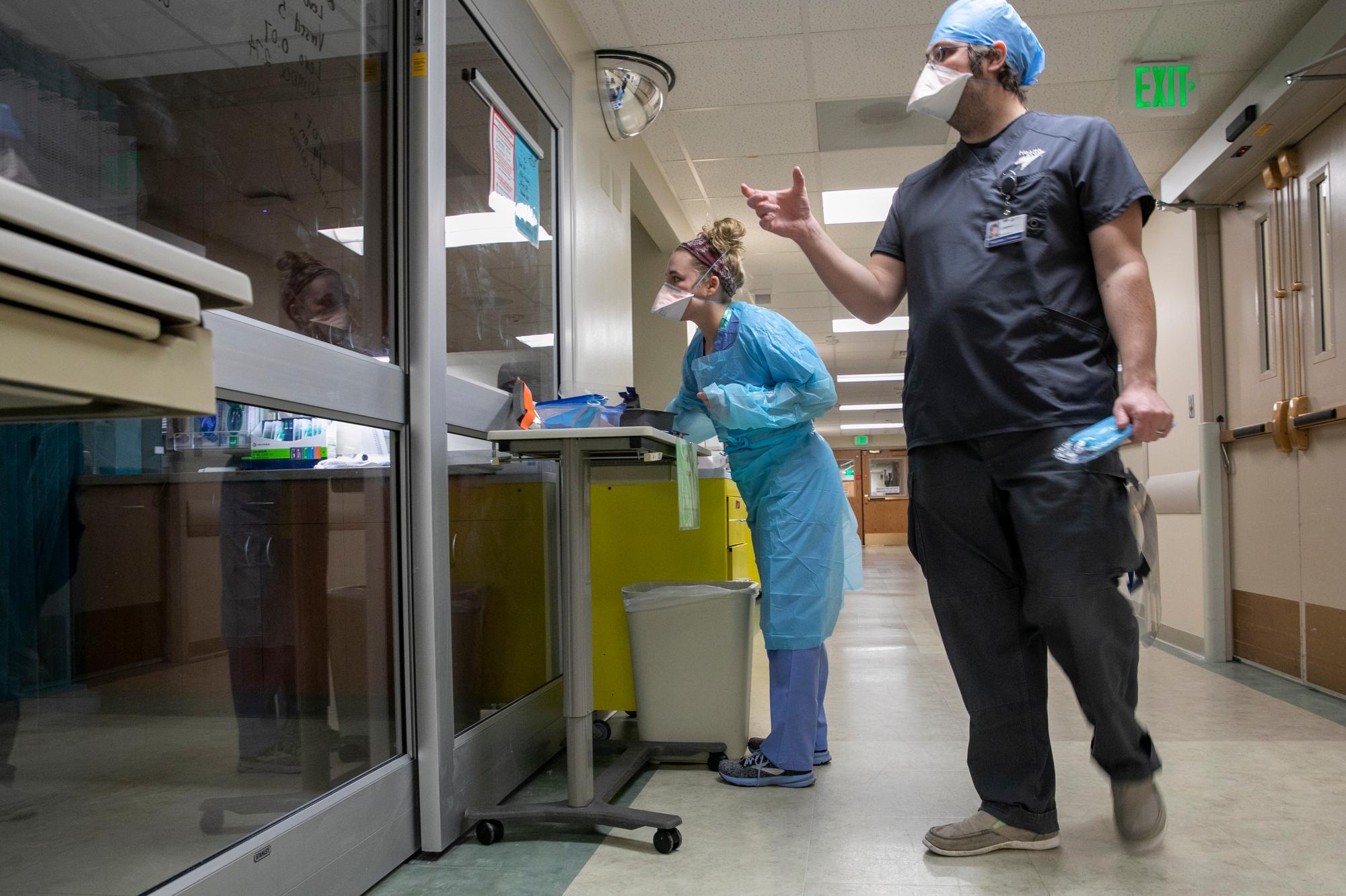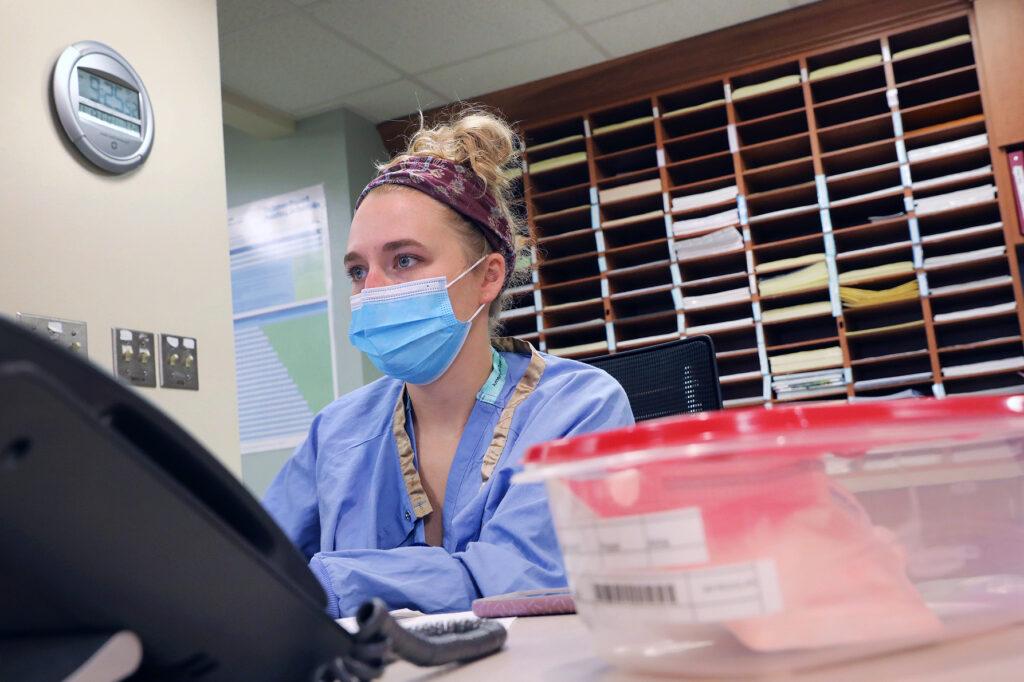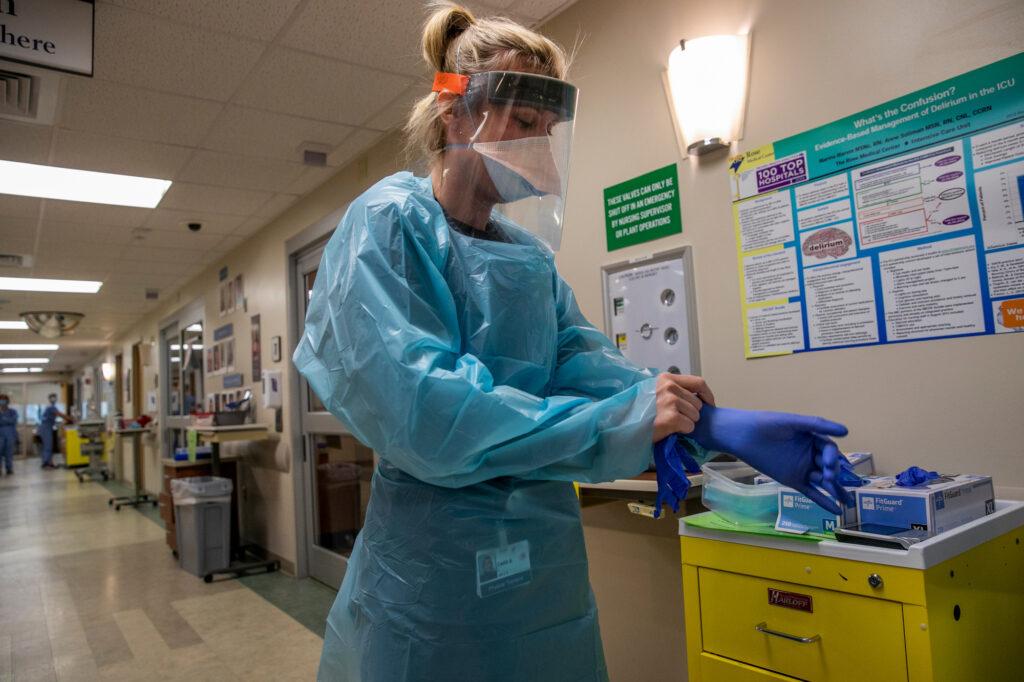
Updated at 10:00 a.m. on November 5: On Wednesday, hospitals and health systems activated the highest tier of the state's patient transfer system. The move allows hospitals to transfer patients to any hospital in the state, even if the patient doesn't agree to the move. You can read more about what that means here.
Our original story follows below.
Gov. Jared Polis opened the door to letting hospitals decline to admit or treat some patients as he signed a pair of executive orders Sunday to help the state deal with a high level of COVID-19 hospitalizations, tight hospital capacity and staff shortages.
There are nearly 1,200 COVID-19 patients hospitalized in Colorado, the most since December, as the highly transmissible delta variant continues to run roughshod through the state’s unvaccinated population. Nearly 80 percent of those hospitalized with coronavirus are unvaccinated, and almost 40 percent of hospitals expect to be short staffed during the next week.
“I am very concerned that we are going to exceed capacity and what dictates capacity is going to be the number of safely staffed beds,” said Dr. Anuj Mehta, a pulmonologist with National Jewish Health and Denver Health, who serves on the Governor’s Expert Emergency Epidemic Response Committee. “It's no longer a question of ventilators. It's a question of safely staffed beds. If you typically have one nurse for two ICU beds, and now you're asking that one nurse to care for four ICU patients, that's not safe anymore.”
COVID-19 vaccination levels have risen steadily in Colorado for months, with children younger than 12-years-old ineligible to get vaccinated. As of Nov. 2, the CDC voted to approve vaccines for children ages 5- to 11-years-old. The statewide vaccination rate is higher than 60 percent overall, which means more than 2 million people in the state are still unvaccinated.
The executive orders represent a big warning flare to Coloradans that the state could be in for some of its roughest months of the pandemic as the holiday season approaches.

What the new executive health orders say and do
One order authorizes the state health department to direct hospitals and freestanding emergency departments to redirect patients to other facilities.
The other clarifies when emergency decision-making measures, called “Crisis Standards of Care,” can be activated. It also directs the state's insurance division to prepare emergency rules to help address staffing shortages.
Both orders expire in a month but can be reactivated.
Colorado is able to activate its Crisis Standards of Care in sections. No plans are currently active, but the governor's move Sunday opens the door for that.
The guidelines essentially set out how to make the most grave medical decisions if the crisis overwhelms hospitals and resources become scarce. They help dictate how the medical community should allocate things such as ventilators and intensive care unit beds in extreme cases when patient needs exceed the resources available. Those standards would help determine who gets care and at what level.
In practice, invoking the standards is more likely to mean that one hospital can transfer a patient to another, less crowded, hospital, even over the patient's objection.
Hospitals in other western states like New Mexico, Wyoming, Utah, Idaho, Montana, and Alaska have all either activated their own crisis standards or have come close in recent weeks.
Currently, 78 percent of those hospitalized for COVID-19 are unvaccinated, and they aren't divided evenly across the state. On the Western Slope in Montrose County, for example, just 54.8 percent of the eligible population has received even one dose of the vaccine. Consequently, that region of the state is out of ICU capacity. Meanwhile, up the road in Eagle County in the central mountains, where 92.3 percent of the eligible population has received at least one dose, 57 percent of ICU beds are available.

Colorado has response plans but no statewide mandates
Should the crisis deepen in parts of Colorado, the state has individual plans for personal protective equipment, staffing, EMS and hospitals to help decide which patients get what levels of care. There’s also one for palliative care and hospice services.
PPE was in short supply and presented a huge challenge early in the pandemic, but that plan was deactivated in June 2020. The ones regarding health care staffing and EMS were deactivated in February as the state came down off the big peak at the end of last year.
At the same time, Polis took no action to mandate changes among people at risk of spreading the virus, like a statewide mask mandate or restrictions on public gatherings. Since responding aggressively at the start of the pandemic with what amounted to lockdown orders, the governor has been reluctant to institute anything similar.
Frontline providers have said healthcare workers are exhausted heading into their 20th month of the pandemic. If the hospitals fill up too much, everything gets more challenging. Resources get scarce, hospitals need to move people around, staffing gets pinched, frontline nurses and doctors have to work longer shifts. The potential to compromise the quality of care grows.
- Colorado’s vaccine mandate did drive a lot of health care and government workers to get the shot — some more than others, though
- The COVID vaccine will soon be available for 5 to 11 year-olds. Here’s what Colorado parents and kids say about it
- How will Colorado vaccinate thousands of children ages 5 to 11? With the help of pediatric offices, schools and maybe even zoos
- Colorado’s veteran living centers prevented COVID-19 better than similar facilities, audit finds
- Ball Arena will require proof of COVID-19 vaccination or negative test for events
- Colorado COVID-19 hospitalizations keep rising, with unvaccinated patients filling ICUs and acute care wards
Ideally, Colorado’s pandemic curve will start to trend downward before the holidays.
“Surely people are going to mix and they're going to travel. And that is a concern,” said Dr. Jon Samet, an epidemiologist and the dean at Colorado’s School of Public Health, who directs COVID-19 modeling for the state.
He said more trouble would be ahead if the state doesn’t see virus trends improve before Thanksgiving. “It will be really another challenge if our curve was not turning down, and we superimposed all the travel and mixing.”
The state and public health experts continue to stress the importance of measures people have heard about for months: vaccination, testing, masking, distancing and ventilation.

Updates take effect for health orders around masking, boosters and more
Late Sunday, the state’s health department also took steps to extend, update or issue new public orders, including one to delay cosmetic procedures. The goal is to ease hospital capacity.
The Colorado Department of Public Health and Environment issued that public health order “to give hospitals greater capacity to serve Coloradans during the pandemic,” the agency said in a statement. It requires hospitals, hospital-owned ambulatory surgical centers, and outpatient surgery centers to delay cosmetic procedures for up to six months if the delay “would not cause harm to life, limb or function.”
CDPHE also extended another public health order that includes limited requirements to mitigate the spread of COVID-19 in Colorado, such as face coverings in some settings. It additionally requires hospitals to provide the state with key information that will let it assess the statewide capacity to provide necessary medical care and services.
Another public health order now includes a provision requiring providers to administer second shots and any additional or booster shots regardless of where the individual received prior vaccinations. It also requires providers to administer vaccines to any individual who says that they meet the criteria approved by the FDA and recommended by CDC. Finally, it requires vaccine administrators to submit vaccination and demographic data to CDPHE within 48 hours of administration.
Editor's note: this story has been updated to reflect the CDC's vote to approve vaccines for 5- to 11-year-olds.









